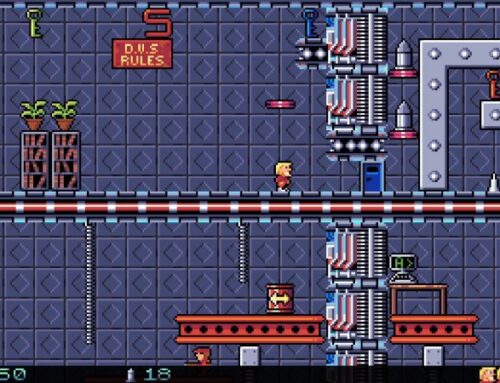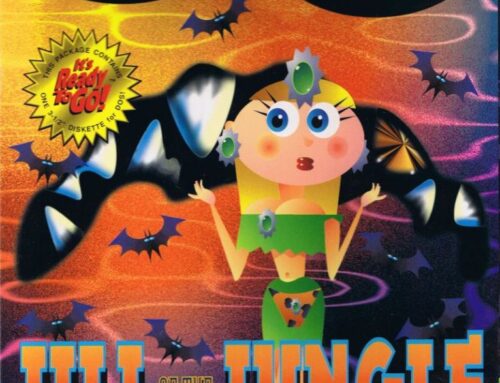Dizzy the Adventurer, an NES remake of Dizzy’s sixth adventure Prince of the Yolkfolk, is a great way to get into Dizzy games. And, conveniently, you can nab it as part of the excellent Oliver Twins Collection cartridge for Evercade, among other sources.
The Dizzy games from The Oliver Twins and CodeMasters are indisputable classics of the 8-bit era — particularly in Europe, where they formed a defining part of the home computer gaming scene on budget-friendly platforms such as the ZX Spectrum. But while Dizzy and friends had numerous outings on the 8-bit NES via a combination of CodeMasters and Camerica’s unlicensed carts and the ill-advised Aladdin Deck Enhancer module, none of these titles managed to quite capture the imaginations of console game players in quite the same way.

Which is a shame, because in many ways the NES versions of Dizzy games are much more enjoyable — or at least newcomer-friendly — than the original 8-bit home computer versions. They’re less punishing; they’re less prone to unfair, annoying game design decisions; and finishing them is something that should actually be within reach of most players. On top of that, these new versions gave titles in the series that were perhaps regarded as a little weaker another chance to succeed — and it’s in this aspect that Dizzy the Adventurer really shines in comparison to its source material Prince of the Yolkfolk.
For the uninitiated, mainline Dizzy games are the very definition of “arcade adventure“. This is a genre that doesn’t really exist any more, but it was huge for a period in the 8-bit and 16-bit home computer eras in Europe.
As the name suggests, arcade adventures combine elements of arcade games — score, lives, sometimes time limits, a need for dexterity and accuracy — with the puzzle solving, inventory management and interactive storytelling of adventure games. These days, some people find the format a little hard to swallow, since the ability to run out of lives and get a hard Game Over feels fundamentally incompatible with the modern adventure game format, particularly since most arcade adventures are short enough that a save function was not deemed necessary.

What’s worth remembering, though, is that early adventure games — particularly those delivered primarily or exclusively via text — offered plenty of opportunities to meet a sticky end, and usually in those cases you didn’t have any “lives” as a safety net against any unfortunate happenstances. Plus, if you really don’t rate your own skills at the “arcade” part of the “arcade adventure” equation, most means of playing old games these days — including the aforementioned Evercade — provide the opportunity to save your game at will, even if the original game didn’t support such a feature.
In the specific case of Dizzy the Adventurer, we join the action as Dizzy has been locked in a cave after his girlfriend Daisy pricked her finger on a spinning wheel and fell asleep in the fortress of Zaks the evil wizard, the series’ recurring antagonist. It’s up to Dizzy to get out of his predicament, save Daisy and, inevitably, deal with a whole host of other problems plaguing the kingdom in the process.
The original Prince of the Yolkfolk is regarded as one of the weaker Dizzy adventures due to its relatively small size and the fact it has a higher than average number of “red herring” items scattered around the place. While Dizzy the Adventurer doesn’t really make the game significantly bigger in geographical terms, it does at least provide uses for some of the items that were completely useless in the home computer versions, and the result is a satisfyingly self-contained feeling adventurer that, with a bit of practice, most players should be able to romp through in an hour or less.

That “practice” part is important, though. While Dizzy the Adventurer is relatively light on the “arcade” side of things — there are relatively few things that will kill you over the course of the whole thing in comparison to some of the other titles in the series — there are still plenty of opportunities to mess things up if you don’t take care. And, if you’re playing the game as originally intended without save states, that means every so often you’ll have to start over from the beginning.
This can be annoying, particularly if you’re more accustomed to modern games with generous autosave systems. But at the same time, there’s a strange sort of pleasure in repeatedly running through the parts of the game you’re familiar with, getting more and more proficient with them each time you play. I can see the Dizzy games being great titles with which to develop speedrunning skills, since their distinct handling, relatively non-linear nature and clear solutions mean that there’s a clear “optimal” route through them — and one which doesn’t require the use of glitches or tools to discover.
Honestly, I was surprised how compelled to return to Dizzy the Adventurer I found myself, even after suffering frustrating deaths on more than one occasion. Rather than simply turning the game off in disgust, I felt myself wanting to try again; I wanted to see if the solution I had in mind for the puzzle I’d died on the way to was really the right one. And I wanted to finish the damn thing — even if Dizzy games are, on the whole, not particularly known for their satisfying end sequences!

As it turned out, Dizzy the Adventurer ended up being the first Dizzy game I’d ever finished without the aid of a walkthrough or save states. And, despite the rather weak ending, I came away from the experience satisfied and happy with what I’d just spent a couple of hours doing. And I wanted more. So I almost immediately turned to Wonderland Dizzy… but that’s a tale for another day, I feel!
Screenshots from the Evercade version.




